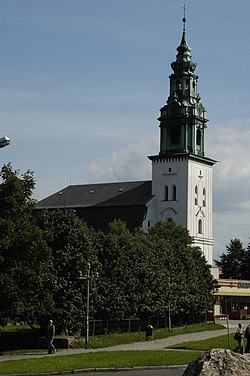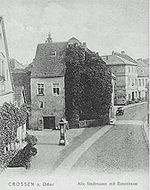| Revision as of 02:42, 8 September 2007 edit71.137.202.89 (talk) m← Previous edit | Revision as of 02:50, 8 September 2007 edit undo71.137.202.89 (talk) fixing links previously messed upNext edit → | ||
| Line 134: | Line 134: | ||
| ==External links== | ==External links== | ||
| {{commonscat|Krosno Odrzańskie}} | |||
| * | * | ||
| * | * | ||
Revision as of 02:50, 8 September 2007
- Not to be confused with Krosno in the Subcarpathian Voivodeship
| Krosno Odrzańskie | |
|---|---|
| Town | |
 Parish Church (Fara) Parish Church (Fara) | |
 Coat of arms Coat of arms | |
| Country | Poland |
| Voivodeship | Lubusz |
| Powiat | Krosno Odrzańskie County |
| Gmina | Krosno Odrzańskie |
| City Rights | before 1238 |
| Government | |
| • Mayor | Andrzej Chinalski |
| Area | |
| • Total | 8.11 km (3.13 sq mi) |
| Elevation | 50 m (160 ft) |
| Population | |
| • Total | 13,000 |
| • Density | 1,600/km (4,000/sq mi) |
| Time zone | UTC+1 (CET) |
| • Summer (DST) | UTC+2 (CEST) |
| Postal code | 66-600 to 66-603 |
| Area code | +48 68 |
| Car Plates | FKR |
| Website | www.krosnoodrzanskie.pl |
Krosno Odrzańskie (Template:Lang-de) is a city on the east bank of Oder River, at the confluence with Bober. The town in Western Poland with 12,500 inhabitants (2002) is the capital of Krosno County. It is assigned to the Lubusz Voivodeship (since 1999), previously part of Zielona Góra Voivodeship (1975-1998).
History
It was first mentioned as Crosno in 1005 and was chartered as a town in 1201. Due to its important strategic location the town played an important role in the protective system at the western borders of Poland during the 11th to 13th centuries. A stone castle was built by the Silesian Piasts in the 13th century. The duchess of Silesia Hedwig of Andechs took refuge in it during the Mongol attacks. The town changed hands several times, once it went as payment to Brandenburg soldiers.

When the Silesian Piast Henry of Głogów died in 1476, his widow Barbara von Brandenburg, daughter of Brandenburg Elector Albert Achilles, inherited the territory of Crossen, while the area was part of Bohemian lien in 1482. Several claims ended when the emperor Ferdinand I renounced all rights to Crossen in 1538, thereby finalizing the district's belonging to Brandenburg. Since then the Brandenburg, later Brandenburg-Prussia and Prussia Hohenzollern electors held the title Duke of Silesia and showed the black Silesian eagle along with other states belonging to Brandenburg.
The emperors held on to further Silesian territory, also inherited by Brandenburg, until in 1742 that became part of Brandenburg-Prussia as well. The Crossen district was part of Prussia and Germany (as Lower Silesia) and remained so until 1945, when it was conquered by Soviet Union and came under Polish administration as Krosno.
Due to war and expulsion, the population was reduced from 10,800 in 1939 to 2,000 in 1946.
Famous People
- Georg Wenzeslaus von Knobelsdorff (1699-1753) painter and architect
- Johann Friedrich Schönemann (1704-1782), theater director
- Rudolf Pannwitz (1881-1969), author
- Hans Egidi (1890-1976), former president of court
- Alfred Henschke ps.Klabund (1890-1928), author
- Tomasz Kuszczak - Poland national football team and Manchester United goalkeeper
- Aneta Pastuszka - Olympic canoer
External links
- 1615 Map of Brandenburg with Duchy of Crossen on Oder river
- Official town website
- Map via mapa.szukacz.pl
52°03′N 15°05′E / 52.050°N 15.083°E / 52.050; 15.083
This Lubusz Voivodeship location article is a stub. You can help Misplaced Pages by expanding it. |